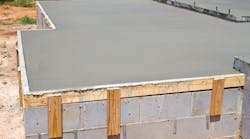Latest from Plumbing
Sponsored
Concrete slab foundation homes became popular in the early 1900s and increased with time. They went mainstream for a reason, but they tend to complicate the maintenance and functionality of other home systems, including plumbing.
Today, 54% of new single-family homes are built on slabs, which means these plumbing and foundation problems are still relevant today. Understanding the causes and signs of damage can help contractors know how to guide homeowners should these problems arise.
Keep reading to learn more about plumbing problems common in concrete slab foundation homes and how to solve them.
Why Concrete Slabs Make Plumbing Problems Complicated
Undoubtedly, concrete slabs have advantages over other foundations — that’s why developers still use them today. Specifically, these slabs are cost-effective, protect against pests, and reduce the risk of flooding and leaking gasses.
However, they also have some disadvantages, especially when it comes to plumbing. Here are three examples.
It is difficult to cut through
If there is a plumbing leak, workers must cut through the concrete to reach the damaged pipes. In general, this makes them tough to access and repair.
Plus, while fixing one part, there’s always the potential to damage another unintentionally. Cutting or jackhammering concrete is a dirty and noisy task, which may disrupt a homeowner’s schedule.
Cutting takes time and money
Demolishing concrete to access a damaged waterline takes time and money. Homeowners need to hire specialized contractors to locate the leak and jackhammer or cut the foundation.
While the process itself takes considerable time, most owners do not notice a leak until damage has already occurred. Repairing this kind of damage and drying out the concrete can also be expensive.
Concrete absorbs water
Concrete is a porous surface, which means it absorbs water. While the water can pass through concrete’s pores and tunnels, it can damage the material’s integrity with time. Water from a leaking pipe will make its way through the foundation, wearing away at the inner channels and contributing to freeze and thaw damage. Most homeowners don’t even realize there’s been a leak until they find stains or water puddles on the concrete.
Wet concrete holds its moisture, which leads to mold growth and foul odors. If there is a mold infestation, it will take homeowners more time and money to fix, and it could quickly compromise their entire foundation.
Signs of Plumbing Problems
It pays to know what to look for, and some signs of plumbing problems may not be obvious.
Before any physical red flags begin to show, homeowners may notice a sudden increase in their water bills. Another sign is an abrupt decrease in water pressure. If the leak is significant, some people may even hear rushing water under their floor.
Physical signs include:
● Water stains on the foundation floor.
● Pooling water or depressions in the yard.
● Apparent foundation damage.
● Puddles on the foundation floor.
● Cracks in the walls or foundation of a property.
● Soft spots on the floor.
● Foul odors or signs of mildew.
Contractors and homeowners should pay attention to these indicators. Waiting can cause extensive damage if it’s left unchecked. When working on the foundation of a concrete slab home, contractors should encourage their clients to keep an eye on the area in the weeks following the repairs.
How to check if there is a leak
To determine if there’s a slab leak, the homeowner or contractor should shut off all water sources. After every faucet and water outlet is off, watch the water meter. Make sure to wait for at least a few minutes when viewing the gauge, as an ice-maker or automated setting may be pulling water.
If the water meter gauge is moving and all of the water is off, there is likely a water leak.
Common causes
Plumbing problems occur with time, especially if the pipes are old or made from inferior materials.
Galvanized pipe was regularly used for water supply and drain lines in older homes. While it is a lead-free material, it can rust over time, which can cause leaks and water contamination.
However, other factors can also play a role and cause slab leaks. Specifically, penetration from tree roots as they expand can put pressure on the pipes and cause damage. Additionally, changes to the foundation can cause plumbing problems.
As the foundation freezes and thaws, it puts pressure on the pipes underground. The added strain can cause damage. Likewise, if the foundation cracks or shifts, the movement can lead to a leak. Unfortunately, even repairing foundation problems can lead to plumbing issues.
Solving concrete slab problems
1 - Isolate the leaky area.
The first step in repairing the issue is to find the source of the leak. Workers will need a specialized listening device to pinpoint the exact location before cutting into the concrete.
After turning off the water, a specialist will pump air into the pipe. The person with the listening device will be able to hear where the air is escaping from.
2- Repair the damage.
After finding the leak and gaining access, they’ll need to replace the fittings and repair the damaged area. This may mean replacing a section of the pipe or using an epoxy sealer. Contractors will need to follow repair methods that match the piping material, as copper pipes have different properties than galvanized metal or cast iron.
If the pipes are in good condition, it makes sense to repair the existing damage and keep the current plumbing layout. This is usually cheaper for the homeowner because it takes less time and is less labor-intensive than rerouting all of the piping. While insurance will likely cover the maintenance repairs, they may not cover a complete overhaul of the system.
3 - Re-route the piping
If the plumbing is in poor condition — or there’s a strong chance for future leaks — it may be best to reroute the piping. A professional plumber can reroute the piping to a more accessible location, like the walls or ceiling. By repiping the entire system, homeowners are saved from future costly damage and repair expenses.
It’s best to consider rerouting the piping if the climate is freezing and there are regular temperature drops or if there have been previous leaks.
The bottom line
Plumbing problems in concrete slab foundation homes are serious. If a homeowner or contractor believes there’s an issue, they should hire a specialist to come out and check as soon as possible. Recognizing the red flags and understanding the common causes of these plumbing problems can help everyone better prepare for the unexpected.
Rose Morrison is a freelance writer who covers construction, home improvement, and contracting topics. She is also the managing editor of Renovated.com, a site dedicated to the latest trends in the home industry. She has a passion for innovative technologies that are making the home industry sustainable and efficient. Check out Renovated.com to see more of her work.

Rose Morrison
Rose Morrison is a freelance writer who covers construction, home improvement, and contracting topics. She is also the managing editor of Renovated.com, a site dedicated to the latest trends in the home industry. She has a passion for innovative technologies that are making the home industry sustainable and efficient. Check out Renovated.com to see more of her work.


